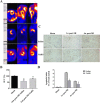Hydrogen Sulfide Reduces Recruitment of CD11b+Gr-1+ Cells in Mice With Myocardial Infarction
- PMID: 28185610
- PMCID: PMC5657722
- DOI: 10.3727/096368917X695029
Hydrogen Sulfide Reduces Recruitment of CD11b+Gr-1+ Cells in Mice With Myocardial Infarction
Abstract
The present study aimed to elucidate the mechanisms by which hydrogen sulfide (H2S) attenuates left ventricular remodeling after myocardial infarction (MI). MI was created in mice by left coronary artery ligation. One group of mice received injections of the H2S donor sodium hydrosulfide (NaHS) immediately before and 1 h after ligation, while the control group received saline alone. During both the subacute and chronic stages (1 and 4 weeks postinfarction, respectively), NaHS-treated mice demonstrated attenuation of cardiac dilation in the infarcted myocardium. Furthermore, fewer CD11b+Gr-1+ myeloid cells were detected in the infarct myocardium and peripheral blood from NaHS-treated mice, while more CD11b+Gr-1+ cells remained in the spleen and bone marrow in these animals. NaHS-treated mice also exhibited reduction in cardiomyocyte apoptosis, interstitial fibrosis, cardiac hypertrophy, and pulmonary edema, as well as overall better survival rates, when compared to controls. Thus, exogenous H2S has favorable effects on cardiac remodeling after MI. These observations further support the emerging concept that H2S treatment might have therapeutic benefits in the setting of ischemia-induced heart failure.
Figures







Similar articles
-
Hydrogen sulfide attenuates the recruitment of CD11b⁺Gr-1⁺ myeloid cells and regulates Bax/Bcl-2 signaling in myocardial ischemia injury.Sci Rep. 2014 Apr 24;4:4774. doi: 10.1038/srep04774. Sci Rep. 2014. PMID: 24758901 Free PMC article.
-
Hydrogen sulfide mitigates cardiac remodeling during myocardial infarction via improvement of angiogenesis.Int J Biol Sci. 2012;8(4):430-41. doi: 10.7150/ijbs.3632. Epub 2012 Feb 28. Int J Biol Sci. 2012. PMID: 22419888 Free PMC article.
-
Sodium hydrosulfide prevents myocardial dysfunction through modulation of extracellular matrix accumulation and vascular density.Int J Mol Sci. 2014 Dec 12;15(12):23212-26. doi: 10.3390/ijms151223212. Int J Mol Sci. 2014. PMID: 25514418 Free PMC article.
-
Exogenous hydrogen sulfide (H2S) protects against regional myocardial ischemia-reperfusion injury--Evidence for a role of K ATP channels.Basic Res Cardiol. 2006 Jan;101(1):53-60. doi: 10.1007/s00395-005-0569-9. Epub 2005 Nov 21. Basic Res Cardiol. 2006. PMID: 16328106
-
Hydrogen Sulfide as a Potential Alternative for the Treatment of Myocardial Fibrosis.Oxid Med Cell Longev. 2020 Jan 23;2020:4105382. doi: 10.1155/2020/4105382. eCollection 2020. Oxid Med Cell Longev. 2020. PMID: 32064023 Free PMC article. Review.
Cited by
-
An Update on Hydrogen Sulfide and Nitric Oxide Interactions in the Cardiovascular System.Oxid Med Cell Longev. 2018 Sep 9;2018:4579140. doi: 10.1155/2018/4579140. eCollection 2018. Oxid Med Cell Longev. 2018. PMID: 30271527 Free PMC article. Review.
-
Modulation of EndMT by Hydrogen Sulfide in the Prevention of Cardiovascular Fibrosis.Antioxidants (Basel). 2021 Jun 3;10(6):910. doi: 10.3390/antiox10060910. Antioxidants (Basel). 2021. PMID: 34205197 Free PMC article. Review.
-
Hydrogen Sulfide Protects Human Cardiac Fibroblasts Against H2O2-induced Injury Through Regulating Autophagy-Related Proteins.Cell Transplant. 2018 Aug;27(8):1222-1234. doi: 10.1177/0963689718779361. Epub 2018 Jul 19. Cell Transplant. 2018. PMID: 30022684 Free PMC article.
-
Plants and Mushrooms as Possible New Sources of H2S Releasing Sulfur Compounds.Int J Mol Sci. 2023 Jul 25;24(15):11886. doi: 10.3390/ijms241511886. Int J Mol Sci. 2023. PMID: 37569263 Free PMC article. Review.
-
Cardioprotective Effects of Hydrogen Sulfide and Its Potential Therapeutic Implications in the Amelioration of Duchenne Muscular Dystrophy Cardiomyopathy.Cells. 2024 Jan 15;13(2):158. doi: 10.3390/cells13020158. Cells. 2024. PMID: 38247849 Free PMC article. Review.
References
Publication types
MeSH terms
Substances
LinkOut - more resources
Full Text Sources
Other Literature Sources
Medical
Research Materials

